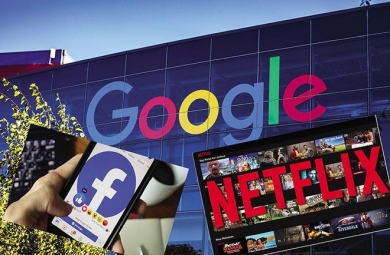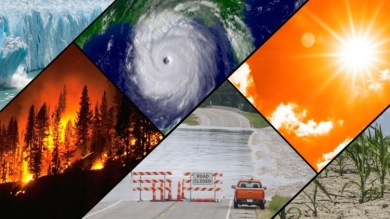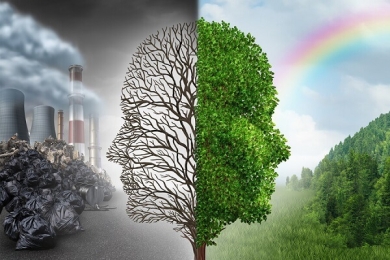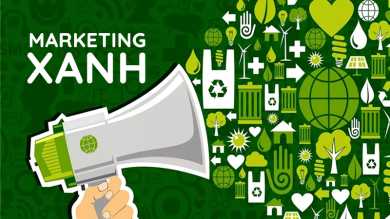Humanity is facing major global challenges that are transnational in nature and transinstitutional in solution.
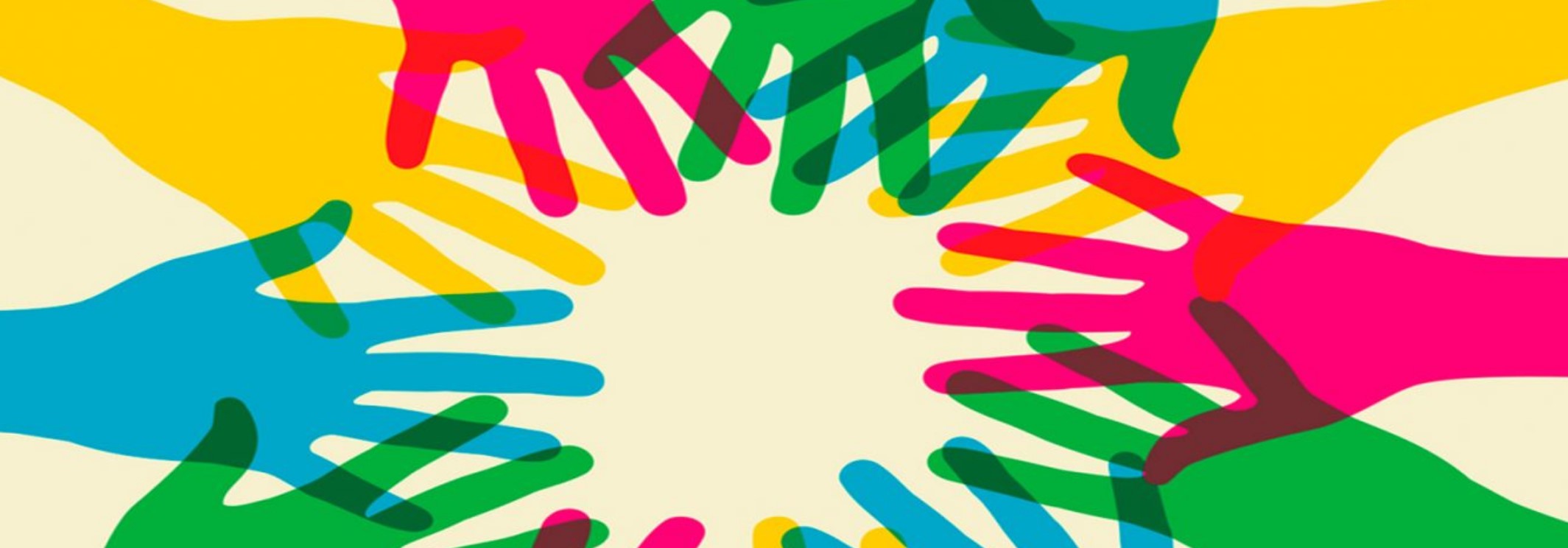
This essay confronts fifteen of the biggest issues, including how to achieve sustainable development, guarantee access to clean drinking water, foster ethical market economies and fight new as well as re-emerging diseases. While the panorama may appear pessimistic, humanity is winning more than losing – even if where we are losing is very serious. But these challenges cannot be addressed by any single government or institution acting alone. They require collaborative actions among governments, international organizations, universities, NGOs and creative individual. We need a serious focus on green growth, falling water tables, rising food/water/energy prices, population growth, resource depletion, climte change, terrorism, and changing disease patterns, otherwise the results may well be catastrophic.
Although many of the trends and possible future developments explained in this chapter can be quite depressing, based on sixteen years of research on the 15 Global Challenges identified by The Millennium Project, I have come to the conclusion that we have the resources and ideas to address them, and that there is more agreement about how to build a better future than is evident in the media, yet decision-making and institutional capacity — so far — is insufficient to make the decisions fast enough and on the scale large enough to build a better future.
Nevertheless, pessimism is unfounded, and it gives the excuse not to try to make better decisions that improve the future. Humanity is winning more than losing, although where we are losing is very serious. There is no guarantee that all will work out well, but the odds are in our favor — especially if more people and institutions understand that it is possible that we can all succeed, because we are already succeeding in many areas. If, however, more people and institutions do not get more strategic about addressing these challenges, then the negative scenarios are more likely.
When you consider the many wrong decisions and good decisions not taken — day after day and year after year around the world — it is amazing that we are still making as much progress as we are.
Fifty years ago, people argued that poverty elimination was an idealistic fantasy and a waste of money to try and eliminate; however, extreme poverty has fallen from 52 percent of the world in 1981 to about 20 percent in 2010. Extraordinary! The majority of the world was in extreme poverty just thirty-one years ago and now less than 20 percent?! Pessimists are just not doing their homework. And today people argue about the best ways to achieve that goal, not whether or not it is worthwhile to try.
Twenty-five years ago, people thought that civilization would end in a thermo-nuclear world war III between the USSR and the USA; today people think everyone should have access to the world’s knowledge via the Internet, regardless of income, nationality, or ideology. Extraordinary change! Within one lifetime. And now, an even more amazing thing: Google is making the phrase “I don’t know” obsolete.
It is possible within twenty-five years that anyone who wants it could have computational power many times beyond their individual brain’s capacity — and have that capacity available twenty-four hours a day, and seven days a week while walking down a street with just voice recognition from imbedded intelligent computer chips in buildings. You won’t need your own computer to access all that.
But we all know the future is not necessarily rosy. If current trends in population growth, resource depletion, climate change, terrorism, organized crime, and disease continue and converge over the next 50–100 years, it is easy to imagine a continually unstable world with a series of catastrophic results. At the same time, if current trends in self-organization via future Internets, transnational cooperation, materials science, 3-D printing, alternative energy, cognitive science, inter-religious dialogues, synthetic biology, and nanotechnology continue and converge over the next 50–100 years, it is easy to imagine a world that works for all.
Computational biophysics can simulate the physical forces among atoms, making medical diagnostics and treatment more individually accurate. Computational biology can create computer matching programs to quickly reduce the number of possible cures for specific diseases, with millions of people donating their unused computer capacity to run the matching programs (grid computing). Computational media allows extraordinary pixel and voxel detail when zooming in and out of 3-D images — making it seem more real than reality. Computational engineering brings together the world’s available information and computer models to rapidly accelerate efficiencies in design. All these are changing the nature of science, medicine, and engineering, and their acceleration is attached to Moore’s law; hence, computational everything will continue to accelerate the knowledge explosion. Tele-medicine, tele-education, and tele-everything will connect humanity, the built environment, and computational everything to address our global challenges.
The world is getting richer, healthier, better educated, more peaceful, and better connected and people are living longer, yet half the world is potentially unstable. Protesters around the world show a growing unwillingness to tolerate unethical decision-making by power elites. An increasingly educated and Internet-connected generation is rising up against the abuse of power. Food prices are rising, water tables are falling, corruption and organized crime are increasing, environmental viability for our life support is diminishing, debt and economic insecurity are increasing, climate change continues, and the gap between the rich and poor continues to widen dangerously.
Information and communications systems from simple mobile phones to supercomputers are augmenting human decision-making. It is reasonable to assume that the accelerating rates of these changes will eventually connect humanity and technology into new kinds of decision-making with global real-time feedback.
We have the resources and ideas to address them, and […] there is more agreement about how to build a better future than is evident in the media, yet decision-making and institutional capacity — so far — is insufficient to make the decisions fast enough and on the scale large enough to build a better future.
But history has taught us that good ideas and technologies can have unintended and negative consequences. These capabilities will eventually make it possible for a single individual acting alone to make and deploy a bioweapon of mass destruction and for organized crime to become far more powerful than today — when its combined income is already twice that of the total of the world’s military budgets. These and other dangerous future possibilities are not inevitable; there are many excellent solutions being pursued and making great progress, unbeknownst to the general public. Every year, The Millennium Project updates data about the global situation and prospects for the future, with most of the data updates going slowly but surely in a positive direction. Nevertheless, the world is in a race between implementing ever-increasing ways to improve the human condition and the seemingly ever-increasing complexity and scale of global problems.
So, how is the world doing in this race? What’s the score so far? A review of the trends of the twenty-eight variables used in The Millennium Project’s global State of the Future Index (SOFI) provides a score card on humanity’s performance in addressing the most important challenges.
An international Delphi panel selected over a hundred indicators of progress or regress for the 15 Global Challenges described later in this chapter. Variables were then chosen that had at least twenty years of reliable historical data. The resulting twenty-eight variables were submitted to an international panel selected by The Millennium Project Nodes to forecast the best and worst value for each variable in ten years. The results were integrated into the 2012 SOFI (Glenn, Gordon and Florescu 2012).
Where are we winning?
- Increasing access to water
- Increasing literacy rates
- Extending life expectancy at birth
- Reducing poverty (living on $1.25 a day)
- Reducing infant mortality
- Reducing war
- Reducing HIV prevalence
- Increasing the number of Internet users
- Increasing GDP per capita
- Increasing the number of women in parliaments
- Increasing secondary school enrollment
- Improving energy efficiency
- Reducing population growth
- Reducing the prevalence of undernourishment
- Reducing nuclear proliferation
Where are we losing?
- Increasing total debt
- Increasing unemployment
- Increasing income inequality
- Increasing the human ecological footprint/reducing biocapacity ratio
- Increasing greenhouse gas emissions
- Increasing terrorist attacks
- Reducing voter turnout
Where is there either no significant change or change is not clear?
- Corruption
- Freedom rights
- Electricity from renewables compared to non-renewables
- Forest lands
- R&D expenditures
- Physicians per capita
The 2012 SOFI in Figure 1 (Ibid.) shows that the ten-year future for the world is getting better — but at a slower rate of improvement than over the past twenty years. However, in many of the areas where we are winning, we are not winning fast enough, such as reductions in HIV, malnutrition, poverty; increasing access to water; and nuclear proliferation. And areas of uncertainty represent serious problems: corruption, political freedom, fossil-fuel consumption, and forest cover. Some of the areas where we are losing could have quite serious impacts, such as unemployment, greenhouse gas emissions, debt, income gaps, and terrorism. Nevertheless, this selection of data indicates that ten years from now, on balance, will be better than today. We are winning more than we are losing.
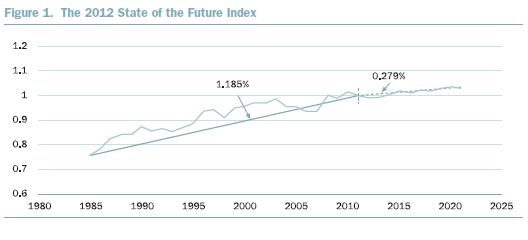
EVOLUTION OF THE 15 GLOBAL CHALLENGES
In 1996, The Millennium Project3 asked several hundred futurists around the world what was going on now that could become very significant to the future in twenty-five years’ time and that is either not know or misunderstood. A total of 182 developments were collected by the Delphi survey. Another set of Delphi surveys and interviews collected and rated 131 actions to address these developments. These were all distilled into fifteen global issues with overviews and strategies.
These global issues identified by the Delphi surveys and interviews in 1996–1997 were:
- World population is growing; food, water, education, housing, and medical care must grow apace.
- Fresh water is becoming scarce in localized areas of the world.
- The gap in living standards between the rich and poor promises to become more extreme and divisive.
- The threat of new and re-emerging diseases and immune micro-organisms is growing.
- Capacity to decide is diminishing (as issues become more global and complex under conditions of increasing uncertainty and risk).
- Terrorism is increasingly destructive, proliferating, and difficult to prevent.
- Population growth and economic growth are interacting adversely with environmental quality and natural resources.
- The status of women is changing.
- Religious, ethnic, and racial conflicts are increasingly severe.
- Information technology offers both promise and peril.
- Organized crime groups are becoming sophisticated global enterprises.
- Economic growth is bringing both promising and threatening consequences.
- Nuclear power plants around the world are aging.
- The HIV epidemic will continue to spread.
- Work, unemployment, leisure, and underemployment are changing.
With sixteen years of hindsight, these issues are still indeed critical to the future. However, The Millennium Project’s Planning Committee at that time felt these issues stressed the problems more than the opportunities, giving an unbalanced view of the future. To correct this, the same process of collecting judgments and research conclusions of futurists via Delphi surveys and interviews was conducted in 1997–1998. This time, the international panel of futurists was asked what positive developments could evolve over the foreseeable future to significantly improve the human condition. A total of 180 developments were identified with 213 actions to increase the likelihood that they will improve the human condition; the results were then distilled to 15 Global Opportunities with overviews and strategies.
The global opportunities identified in 1997–1998 were:
- Achieving sustainable development
- Increasing the acceptance of global long-term perspectives in policymaking
- Expanding the potential for scientific and technological breakthroughs
- Transforming authoritarian regimes to democracies
- Encouraging diversity and shared ethical values
- Reducing the rate of population growth
- Evolving strategies for world peace and security
- Developing alternative sources of energy
- Globalizing the convergence of information and communications technologies (ICT)
- Increasing advances in biotechnology
- Encouraging economic development through ethical market economies
- Increasing the economic autonomy of women and other groups
- Promoting inquiry into new and sometimes counter-intuitive ideas
- Pursuing promising space projects
- Improving institutions
The following year we combined the two lists into 15 Global Challenges through a series of Delphi surveys and interviews, and we identified 213 actions. At this point the representatives for Finland on The Millennium Project Planning Committee said, “Stop! Don’t keep changing. This is a good list. Keep it; we want to use it to evaluate progress in our country. If you keep changing, it will be difficult for us to compare progress from one year to the next.” So the Global Challenges have remained the same.
THE 15 GLOBAL CHALLENGES IN 2012
The 15 Global Challenges from 1999 to 2012 are:
- How can sustainable development be achieved for all while addressing global climate change?
- How can everyone have sufficient clean water without conflict?
- How can population growth and resources be brought into balance?
- How can genuine democracy emerge from authoritarian regimes?
- How can policymaking be made more sensitive to global long-term perspectives?
- How can the global convergence of ICT work for everyone?
- How can ethical market economies be encouraged to help reduce the gap between rich and poor?
- How can the threat of new and re-emerging diseases and immune micro-organisms be reduced?
- How can the capacity to decide be improved as the nature of work and institutions changes?
- How can shared values and new security strategies reduce ethnic conflicts, terrorism, and the use of weapons of mass destruction?
- How can the changing status of women help improve the human condition?
- How can transnational organized crime networks be stopped from becoming more powerful and sophisticated global enterprises?
- How can growing energy demands be met safely and efficiently?
- How can scientific and technological breakthroughs be accelerated to improve the human condition?
- How can ethical considerations become more routinely incorporated into global decisions?
The order of each of the issues, opportunities, and challenges are not prioritized by any definition of importance. Challenge 1 is not more or less important than Challenge 15. The volume of responses from the international panel was used to order the items in each list. The challenges are interdependent: an improvement in one makes it easier to address others; deterioration in one makes it harder to address others. Arguing whether one is more important than another is like arguing that the human nervous system is more important than the respiratory system. These challenges are transnational in nature and transinstitutional in solution. They cannot be addressed by any government or institution acting alone. They require collaborative action among governments, international organizations, corporations, universities, NGOs, and creative individuals.
How can sustainable development be achieved for all while addressing global climate change?
Total human-induced greenhouse gas (GHG) emissions are about 49.5 gigatons of CO2 equivalent per year.5 Nature absorbs about half of this annually, but its ability to do that is diminishing. Global ecosystem services are being depleted faster than nature can resupply. The world is warming faster than the latest IPCC projections.6 According to NOAA, the first six months of 2012 were the hottest in the US since record-keeping began in 1895. Glaciers are melting, polar ice caps are thinning, and coral reefs are dying. Rapid population and economic growth over the past hundred years has reduced environmental viability for life support; the impact over the next hundred years could be far greater. It is time for a US–China Apollo-like ten-year goal and global R&D program to address climate change. These two countries are the greatest emitters of GHGs and have the largest economies. Such a joint program — with other countries joining in — could focus on accelerating the development of new technologies like electric cars, saltwater agriculture, carbon capture and reuse, solar power satellites, pure meat without growing animals, maglev trains, urban systems ecology, and a global climate change collective intelligence to support better decisions and keep track of it all. These technologies would have to supplement other key policy measures, including carbon taxes, cap and trade schemes, reduced deforestation, industrial efficiencies, cogeneration, conservation, recycling, and a switch of government subsidies from fossil fuels to renewable energy.
How can everyone have sufficient clean water without conflict?
Over two billion people have gained access to improved drinking water since 1990, but 783 million people still do not have such access. Water tables are falling around the world, 40 percent of humanity gets its water from sources controlled by two or more countries, and global water demand could be 40 percent more than the current supply by 2030 (2030 Water Resources Group 2009). The slow but steady Himalayan meltdown is one of the greatest environmental security threats in Asia. Its mountains contain 40 percent of the world’s freshwater, which feeds 40 percent of humanity via seven great Asian rivers. Breakthroughs in desalination — such as the pressurization of seawater to produce vapor jets, filtration via carbon nanotubes, and reverse osmosis — are needed along with less costly pollution treatment and better water catchments. Future demand for freshwater could be reduced by saltwater agriculture on coastlines, hydroponics, aquaponics, vertical urban agriculture installations in buildings, the production of pure meat without growing animals, increased vegetarianism, fixes for leaking pipes, and the reuse of treated water.
How can population growth and resources be brought into balance?
The UN mid-range forecast estimates that world population is expected to grow by another two billion in just thirty-eight years, creating an unprecedented demand for resources. Most of that growth will be in low-income urban Asia. Today Asia has 4.2 billion people and is expected to grow to 5.9 billion by 2050. By 2030, the global middle class is expected to grow by 66 percent — about 3 billion more consumers with increased purchasing power and expectations (McKinsey Global Institute 2011). Population dynamics are changing from high mortality and high fertility to low mortality and low fertility. The world’s fertility rate has fallen from 6 children in 1900 to 2.5 today.7 If fertility rates continue to fall, world population could actually shrink to 6.2 billion by 2100, creating an elderly world difficult to support. Today life expectancy at birth is 68 years, which is projected to grow to 81 by 2100.8 By 2050 there could be as many people over 65 as there are under 15,9 requiring new concepts of retirement. Scientific and medical breakthroughs are likely over the next 20–30 years that could give many people longer and more productive lives than most would believe possible today. People will work longer and create many forms of self-employed tele-work, part-time work, and job rotation to reduce the economic burden on younger generations and to maintain living standards. If new concepts of employment are not invented, increased political instability seems inevitable.
How can genuine democracy emerge from authoritarian regimes?
Current demographic shifts and improved education, compounded by economic volatility, are increasing demands for more transparent democratic systems. Although democracy has been growing for over twenty years, Freedom House reports that political and civil liberties declined in 2011 for the sixth consecutive year. New democracies must address previous abuses of power to earn citizens’ loyalties without increasing social discord, slowing the reconciliation process, and reducing human rights. An educated and correctly informed public is critical to democracy; hence, it is important to learn how to counter and prevent various ideological disinformation campaigns, information warfare, politically motivated government censorship, reporters’ self-censorship, and interest-group control over the Internet and other media, while reinforcing the pursuit of truth.
Old ideological, political, ethnic, and nationalistic legacies also have to be addressed to maintain the long-range trend toward democracy. Since democracies tend not to fight each other and since humanitarian crises are far more likely under authoritarian than democratic regimes, expanding democracy is sine qua non for building a peaceful and just future for all. Meanwhile, international procedures are needed to assist failed states or regions within states, and intervention strategies need to be designed for when a state constitutes a significant threat to its citizens or others.
How can policymaking be made more sensitive to global long-term perspectives?
Humanity needs a global, multifaceted, general long-term view of the future with long-range goals to help it make better decisions today to build a brighter future. Attaining such long-range goals as landing on the moon or eradicating smallpox that were considered impossible inspired many people to go beyond selfish, short-term economic interests to great achievements. Short-term, selfish economic decision-making has led to many problems, ranging from the Euro crisis to the political stalemate in Washington and insufficient actions from Rio+20. The options to create and update national, global, and corporate strategic foresight are so complex and are changing so rapidly that it is almost impossible for decision-makers to gather and understand the information required to make and implement coherent policy. At the same time, the consequences of incoherent policies are so serious that new systems for collective intelligence are needed to improve resilience.
National legislatures could establish standing “Committees for the Future,” as Finland has done. National foresight studies should be continually updated, improved, and conducted interactively with issue networks of policymakers and futurists and with other national long-range efforts. Decision-makers and their advisors should be trained in futures research (Glenn and Gordon 2009) for optimal use of these systems. Governments could add foresight as a performance evaluation criterion, add foresight to their training institutions, and require a “future considerations” section be added to policy reporting requirements. Government budgets should consider five-to-ten-year allocations attached to rolling five-to-ten-year SOFIs, scenarios, and strategies. Governments with short-term election cycles should consider longer, more stable terms and funds for the staff of parliamentarians. A successful Global Future Collective Intelligence System should help policymaking become more sensitive to global long-term perspectives. Participatory policymaking processes augmented by e-government services can be created, informed by futures research. Universities should fund the convergence of disciplines, teach futures research and synthesis as well as analysis, and produce generalists in addition to specialists.
These challenges are transnational in nature and transinstitutional in solution. They cannot be addressed by any government or institution acting alone. They require collaborative action among governments, international organizations, corporations, universities, NGOs, and creative individuals.
How can the global convergence of ICT work for everyone?
Over two billion Internet users, over six billion mobile phone subscriptions,10 and uncountable billions of hardware devices are intercommunicating in a vast real-time multi-network, supporting every facet of human activity. It is reasonable to assume that most of the world will experience ubiquitous computing and eventually spend most of its time in some form of technologically augmented reality. The race is on to complete the global nervous system of civilization. Ericsson forecasts that 85 percent of the world’s population will be covered by high-speed mobile Internet in 2017. Humanity, the built environment, and ubiquitous computing are becoming a continuum of consciousness and technology reflecting the full range of human behavior, from individual philanthropy to organized crime. New forms of civilization will emerge from this convergence of minds, information, and technology worldwide.
One of the next “big things” could be the emergence of collective intelligences for issues, businesses, and countries, forming new kinds of organizations able to address problems and opportunities without conventional management. Collective intelligence can be thought of as a continually emerging property that we create (hands on) from synergies among people, software, and information that continually learns from feedback to produce just-in-time knowledge for better decisions than any one of these elements acting alone. Real-time streamed communications shorten the time it takes from situational awareness to decisions. The Web is evolving from the present user-generated and participatory system (Web 2.0) into Web 3.0, a more intelligent partner that has knowledge about the meaning of the information it stores and has the ability to reason with that knowledge, using conceptual descendants of today’s Jeopardy-beating Watson from IBM and Apple’s affectionate Siri.
Low-cost computers are replacing high-cost weapons as an instrument of power in asymmetrical warfare. Cyberspace is also a new medium for disinformation among competing commercial interests, ideological adversaries, governments, and extremists, and it is a battleground between cybercriminals and law enforcement. Fundamental rethinking will be required to ensure that people will be able to have reasonable faith in information. We have to learn how to counter future forms of information warfare that could otherwise lead to the distrust of all forms of information in cyberspace. Nevertheless, the value of ICT for reducing the divisions among people outweighs its divisiveness. It is hard to imagine how the world can work for all without reliable tele-education, tele-medicine, and tele-everything. Universal broadband access should become a national priority for developing countries to make it easier to use the Internet to connect developing-country professionals overseas with the development processes back home, improve educational and business usage, and make e-government and other forms of development more available.
How can ethical market economies be encouraged to help reduce the gap between rich and poor?
Assuming no new European crisis and that Europe’s recession will only shrink their economy by –0.3 percent, the IMF estimates that the world economy will grow at 3.5 percent in 2012. With world population growth at 1 percent, humanity will get about 2.5 percent wealthier by traditional standards. According to the World Bank, extreme poverty ($1.25/day) has fallen from 1.94 billion people (52 percent of the world) in 1981 to 1.29 billion (about 20 percent) in 2010, while world population increased from 4.5 billion to nearly 7 billion during the same time. At this rate, however, about one billion people might still be living in extreme poverty in 2015.11 World unemployment grew to 9 percent in 2011 from 8.3 percent in 2010.12 The landscape of geo-economic power is changing rapidly as the influence of BRIC and other emerging economies as well as of multinational enterprises is rising. Lower- and middle-income countries with surplus labor will be needed in higher-income countries with labor shortages. This could continue the brain drain problem, yet online computer matching systems can connect those overseas to the development process back home.
The 2012 State of the Microcredit reports that the number of very poor families receiving a microloan rose from 7.6 million in 1997 to 137.5 million in 2010, affecting more than 687 million people. The rapid increase of entrepreneurship, self-employment and SMEs, plus global communications and an international division of labor that develop new forms of business governance and relationships, all have the potential to raise living standards and reduce income disparities among nations.
Ethical market economies require improved fair trade, increased economic freedom, a “level playing field” guaranteed by an honest judicial system with adherence to the rule of law, and by governments that provide political stability, a chance to participate in local development decisions, reduced corruption, insured property rights, business incentives to comply with social and environmental goals, a healthy investment climate, and access to land, capital, and information. Approximately one billion people in ninety-six countries now belong to a cooperative, according to the International Co-operative Alliance. Since half of the world’s major economies are multinationals, these businesses play a crucial role in poverty alleviation and in building a sustainable economic system. Direction from central government with relatively free markets is competing with the decentralized, individualized private enterprise for lifting people out of poverty. The world needs a long-term strategic plan for a global partnership between rich and poor. Such a plan should use the strength of free markets and rules based on global ethics.
Humanity, the built environment, and ubiquitous computing are becoming a continuum of consciousness and technology reflecting the full range of human behavior, from individual philanthropy to organized crime. New forms of civilization will emerge from this convergence of minds, information, and technology worldwide.
How can the threat of new and re-emerging diseases and immune micro-organisms be reduced?
The health of humanity continues to improve. The incidence of infectious diseases is falling, as is mortality from such diseases as malaria, measles, and even HIV/AIDS.13 New HIV infections have declined 21 percent over the past 12 years, and AIDS-related deaths dropped by 19 percent between 2004 and 2010.14 The US Food and Drug Administration have approved Truvada, the first drug approved to reduce the risk of HIV infection in uninfected individuals.15 However, a new infectious disease has been discovered each year over the past forty years, twenty diseases are now drug-resistant, and old diseases have reappeared, such as cholera, yellow fever, plague, diphtheria, and several others. In the last six years, more than 1 100 epidemics have been verified. International collaboration to reduce HIV, SARS, and H1N1 (swine flu) has built better global health systems. The dramatic improvements in health and medical services over the past twenty years could be reduced by the ongoing economic problems that are cutting health budgets around the world. The global public debt is about $40 trillion, while the world’s GDP in 2012 is about $80 trillion (PPP). Bill Gates and others supporting health programs are pleading with G20 governments to keep their pledges of $80 billion annually from 2015 onward to create a healthier world.16 Because the world is aging and is increasingly sedentary, cardiovascular disease is now the leading cause of death in the developing as well as the industrial world. However, infectious diseases are the second largest killer and cause about 67 percent of all preventable deaths of children under five (pneumonia, diarrhea, malaria, and measles). Nevertheless, the last twenty years have seen a 30-percent drop in deaths of children under five. Mortality from infectious disease fell from 25 percent in 1998 to less than 16 percent in 2010.17
High-density population growth and slow progress in sanitation in poorer areas keep many preventable diseases active. Some of the largest health impacts remain schistosomiasis (200 million cases), dengue fever (50 million new cases a year), measles (30 million cases a year), onchocerciasis (18 million cases in Africa), typhoid and leishmaniasis (approximately a million each globally), rotavirus (600 000 child deaths per year), and shigella childhood diarrhea (600 000 deaths per year).18 The best ways to address epidemic disease remain early detection, accurate reporting, prompt isolation, and transparent information and communications infrastructure, with increased investment in clean drinking water, sanitation, and handwashing. WHO’s eHealth systems, smartphone technology, international health regulations, immunization programs, and the Global Outbreak Alert and Response Network are other essentials of the needed infrastructure.
How can the capacity to decide be improved as the nature of work and institutions changes?
The acceleration of change and interdependence, plus the proliferation of choices and the growing number of people and cultures involved in decisions, increases uncertainty, unpredictability, ambiguity, and surprise. This increasing complexity is forcing humans to rely more and more on expert advice and computers. Just as the autonomic nervous system runs most biological decision-making, so too are computer systems increasingly making the day-to-day decisions of civilization. The acceleration of change reduces the time from the recognition of the need to make a decision to completion of all the steps to make the right decision. As a result, many of the world’s institutions and decision-making processes are inefficient, slow, and ill informed. Institutional structures are not anticipating and responding quickly enough to the acceleration of change; hence, social unrest is likely to continue until new structures provide better management. This may also trigger a return to the city and subregional cooperation as the locus of policy leadership and management. Today’s challenges cannot be addressed by governments, corporations, NGOs, universities, and intergovernmental bodies acting alone; hence, transinstitutional decision-making has to be developed, and common platforms have to be created for transinstitutional strategic decision-making and implementation.
How can shared values and new security strategies reduce ethnic conflicts, terrorism, and the use of weapons of mass destruction?
Although the vast majority of the world is living in peace, half the world continues to be vulnerable to social instability and violence due to growing global and local inequalities, falling water tables, increasing energy demands, outdated institutional structures, inadequate legal systems, and increasing costs of food, water, and energy. In local areas of worsening political, environmental, and economic conditions, increasing migrations can be expected, which in turn can create new conflict.19 Add in the future effects of climate change, and there could be up to 400 million migrants by 2050,20 further increasing conditions for conflict. Yet the probability of a more peaceful world is increasing due to the growth of democracy, international trade, global news media, the Internet, NGOs, satellite surveillance, better access to resources, and the evolution of the UN and other international and regional organizations.
Ethical market economies require improved fair trade, increased economic freedom, a “level playing field” guaranteed by an honest judicial system with adherence to the rule of law, and by governments that provide political stability and business incentives.
The number of nuclear weapons has fallen from 65 000 in 1985 to 11 540 in 2011.21 Wars — as defined by 1 000 or more battle-related deaths — have been steadily decreasing over the past two decades, although the past two years have seen an increase, mainly due to the Arab Spring/Awakening.22 Terrorism is changing from transnationally organized attacks to attacks by small groups and single individuals.23 Mail-order DNA and future desktop molecular and pharmaceutical manufacturing could one day give single individuals the ability to make and use weapons of mass destruction from biological weapons. Ubiquitous sensor systems in public spaces plus better mental health and education systems will be needed to reduce such future threats. Governments and industrial complexes find themselves under multiple daily cyberattacks (espionage or sabotage) from other governments, competitors, hackers, and organized crime. It seems intellectual software arms races will be inevitable. Backcasted peace scenarios should be created through participatory processes to show plausible alternatives to the full range of conflict possibilities.
How can the changing status of women help improve the human condition?
The empowerment of women has been one of the strongest drivers of social evolution over the past century and is acknowledged as essential for addressing the global challenges facing humanity. Women are increasingly engaged in decision-making, promoting their own views and demanding accountability. Women account for 19.8 percent of the membership of national legislative bodies worldwide, and in thirty-two countries the figure is over 30 percent. Women represent 14.3 percent of the total 273 presiding officers in parliaments.24 There are twenty women heads of state or government. Patriarchal structures are increasingly challenged around the world. Women hold 41 percent of the world’s paid employment, but hold 20 percent of senior manager positions.25 The process toward gender political-economic equality seems irreversible. Meanwhile, violence against women is the largest war today, as measured by deaths and casualties per year. In some areas, violence against women at one point in their lives can be as high as 70 percent.26 About 70 percent of people living in poverty are women, who also account for 64 percent of the 775 million adult illiterates.27
How can transnational organized crime networks be stopped from becoming more powerful and sophisticated global enterprises?
The world is slowly waking up to the enormity of the threat of transnational organized crime (TOC), but it has not adopted a global strategy to counter it. In the absence of such a strategy, TOC income has grown to more than $3 trillion a year. Its potential ability to buy and sell government decisions could make democracy an illusion. Havocscope.com estimates the total black market in only 91 of 196 countries in the world to be valued at $1.93 trillion. There is a degree of double accounting in some of these numbers, but to share the scope of Havocsope’s estimates: corruption and bribery represent $1.6 trillion; money laundering, $1.4 trillion; counterfeiting and intellectual property piracy, $654 billion; global drug trade, $411 billion; financial crimes, $194 billion; environmental crimes, $138 billion; and human trafficking and prostitution, $240 billion. These figures do not include extortion and data from 105 countries; hence, the total organized crime income could be over $3 trillion — about twice as big as all the military budgets in the world.
The UN Office on Drugs and Crime has called on all states to develop national strategies to counter TOC as a whole. This could provide input to the development and implementation of global strategy and coordination. It is time for an international campaign by all sectors of society to develop a global consensus for action against TOC. OECD’s Financial Action Task Force has made forty good recommendations to counter money laundering, but these crimes continue unabated. Two conventions help bring some coherence to addressing TOC: the UN Convention against Transnational Organized Crime, which came into force in 2003; and the Council of Europe’s Convention on Laundering, which came into force in May 2008. Possibly through an addition to one of these conventions or the International Criminal Court, a financial prosecution system could be established as a new body to complement the related organizations addressing various parts of TOC. In cooperation with these organizations, the new system would identify and establish priorities on top criminals (defined by the amount of money laundered) to be prosecuted one at a time. It would prepare legal cases, identify suspects’ assets that can be frozen, establish the current location of the suspect, assess the local authorities’ ability to make an arrest, and send the case to one of a number of preselected courts. Such courts, like UN peacekeeping forces, could be identified and trained before being called into action, so as to be ready for instant duty. Once all these conditions were met, then all the orders would be executed at the same time to apprehend the criminal, freeze access to the assets, open the court case, and then proceed to the next TOC leader on the priority list. Prosecution would be outside the accused’s country. Although extradition is accepted by the UN Convention against Transnational Organized Crime, a new protocol would be necessary for courts to be deputized like military forces for UN peacekeeping, via a lottery system among volunteer countries. After initial government funding, the system would receive its financial support from the frozen assets of convicted criminals rather than depending on government contributions.
How can growing energy demands be met safely and efficiently?
In just thirty-eight years, the world should create enough electrical production capacity for an additional 3.3 billion people. There are 1.3 billion people (20 percent of the world) without electricity today,28 and an additional 2 billion people will be added to the world’s population between now and 2050. Compounding this is the requirement to decommission aging nuclear power plants and to replace or retrofit fossil fuel plants. About 3 billion people still rely on traditional biomass for cooking and heating.29 If the long-term trends toward a wealthier and more sophisticated world continue, our energy demands by 2050 could be more than expected. However, the convergences of technologies are accelerating to make energy efficiencies far greater by 2050 than most would believe possible today. So the world is in a race between making a fundamental transition to safer energy fast enough, and the growing needs of an expanding and wealthier population.
About half of the new energy generation capacity comes from renewable sources today.30 IPCC’s best-case scenario31 estimates that renewable sources could meet 77 percent of global energy demand by 2050, while the World Wildlife Fund claims 100 percent is possible.32 The costs of geothermal, wind, solar, and biomass are falling. Setting a price for carbon emissions could increase investments. If the full financial and environmental costs for fossil fuels were considered — mining, transportation, protecting supply lines, water for cooling, cleanups, waste storage, and so on — then renewables will be seen as far more cost-effective than they are today. Without major breakthroughs in technologies and behavioral changes, however, the majority of the world’s energy in 2050 will still come from fossil fuels. In 2010, the world spent $409 billion on fossil fuel subsidies,33 about $110 billion more than in 2009, encouraging inefficient and unsustainable use.
How can scientific and technological breakthroughs be accelerated to improve the human condition?
The continued acceleration of science and technology (S&T) is fundamentally changing what is possible, and access to the S&T knowledge that is changing prospects for the future is becoming universal. Computational chemistry, computational biology, and computational physics are changing the nature of science, the acceleration of which is attached to Moore’s law. R&D on 3-D printers is merging the industrial, information, and biological revolutions. Synthetic biology is assembling DNA from different species in new combinations to create lower-cost biofuels, more precise medicine, healthier food, new ways to clean up pollution, and future capabilities beyond current belief. Swarms of nanorobots are being developed that should be able to manage nano-scale building blocks for novel material synthesis and structures, component assembly, and self-replication and repair. Although synthetic biology and nanotech promise to make the extraordinary gains in efficiencies needed for sustainable development, their environmental health impacts are in question. CERN, the European Organization for Nuclear Research, announced that it has discovered a Higgs-like boson particle that might explain the fundamental ability of particles to acquire mass, giving rise to future applications of energy and matter unimaginable today. We need a global collective intelligence system to track S&T advances, forecast consequences, and document a range of views so that all can understand the potential consequences of new S&T.
How can ethical considerations become more routinely incorporated into global decisions?
The acceleration of S&T change seems to grow beyond conventional means of ethical evaluation. Is it ethical to clone ourselves or bring dinosaurs back to life or to invent thousands of new life forms from synthetic biology? Public morality based on religious metaphysics is challenged daily by growing secularism, leaving many unsure about the moral basis for decision-making. Many turn back to old traditions for guidance, giving rise to the fundamentalist movements in many religions today. Unfortunately, religions and ideologies that claim moral superiority give rise to “we–they” splits that are being played out in conflicts around the world. The moral will to act in collaboration across national, institutional, religious, and ideological boundaries that is necessary to address today’s global challenges requires global ethics.
Collective responsibility for global ethics in decision-making is embryonic but growing. Corporate social responsibility programs, ethical marketing, and social investing are increasing. New technologies make it easier for more people to do more good at a faster pace than ever before. Single individuals initiate groups on the Internet, organizing actions worldwide around specific ethical issues. News media, blogs, mobile phone cameras, ethics commissions, and NGOs are increasingly exposing unethical decisions and corrupt practices. Advance software experts in the self-organizing international group called Anonymous have become a new force increasing world attention to help the Arab Spring, Wikileaks, the Occupy movement, and opposition to police brutality.
Global ethics are emerging around the world through the evolution of ISO standards and international treaties that are defining the norms of civilization. They may also be evolving from protests around the world that show a growing unwillingness to tolerate unethical decision-making by power elites. The proliferation and scope of unethical decisions that led to the 2008 financial crisis seem not to have been addressed sufficiently to prevent future crises. We need to create better incentives for ethics in global decisions, promote parental guidance to establish a sense of values, encourage respect for legitimate authority, support the identification and success of the influence of role models, implement cost-effective strategies for global education for a more enlightened world, and make behavior match the values people say they believe in. Entertainment media could promote memes like “make decisions that are good for me, you, and the world.”
Collective responsibility for global ethics in decision-making is embryonic but growing. Corporate social responsibility programs, ethical marketing, and social investing are increasing. New technologies make it easier for more people to do more good at a faster pace than ever before.
SOME CONCLUSIONS DISTILLED FROM SIXTEEN YEARS OF RESEARCH ON THE GLOBAL CHALLENGES
Without a serious focus on green growth, falling water tables, rising food/water/energy prices, population growth, resource depletion, climate change, terrorism, and changing disease patterns, catastrophic results around the world are likely and will force migrations over the next few decades to make much of the world increasingly unstable. To prevent this, fortunes will be made in areas such as green nanotech manufacturing, synthetic biology for medicine and energy, methods to increase human intelligence, retrofitting energy plants to produce construction material and buildings to produce energy, transferring agriculture from freshwater to saltwater on coastal regions of the word, electric vehicles, growing pure meat without growing animals, and using the principles of urban systems ecology to make cities become conscious technologies.
The global challenges facing humanity are transnational in nature and transinstitutional in solution. No government, international organization, or other form of institution acting alone can solve the problems described in this report: climate change, cybersecurity threats, organized crime, rich–poor gaps, environmental pollution, international finance, gender discrimination, changing disease situations, and the need for sustainable development. The world may have to move from governance by a mosaic of sometimes conflicting national government policies to a world increasingly governed by coordinated and mutually supporting global policies implemented at national and local levels.
Although many people criticize globalization’s potential cultural impacts, it is increasingly clear that cultural change is necessary to address global challenges. The development of genuine democracy requires cultural change, preventing the transmission of AIDS requires cultural change, sustainable development requires cultural change, ending discrimination against women requires cultural change, and ending ethnic violence requires cultural change.
Economic growth and technological innovation have led to better health and living conditions than ever before for more than half the people in the world, but unless our financial, economic, environmental, and social behaviors are improved along with our industrial technologies, the long-term future is in jeopardy.
Many see the world as a fixed-pie, zero-sum game, with someone’s gain becoming another’s loss. Others see an expanding pie, grown by new efficiencies and innovations, “a rising tide lifting all boats.” And a few others see the world as an exponential growth of pies — with the Internet redistributing the means of production in the knowledge economy, cutting through old hierarchical controls in politics, economics, and finance. They expect a world of unlimited possibilities and think that synergetic analysis will create a better world than decisions based solely on competitive analysis. Countering the “me-first, short-term profits” mindset may be essential to engaging the world in more serious consideration of long-term strategies.
Economic growth and technological innovation have led to better health and living conditions than ever before for more than half the people in the world, but unless our financial, economic, environmental, and social behaviors are improved along with our industrial technologies, the long-term future is in jeopardy. The world needs a long-term strategic plan for improving the human condition for all.

